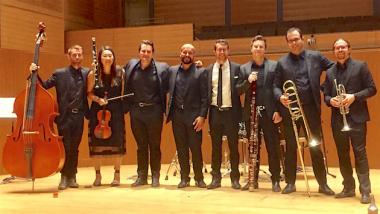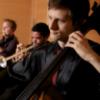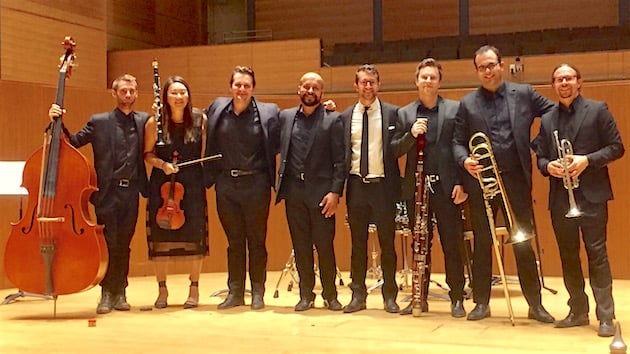
It feels strange to speak of “Modernist” works from a century ago; 2013 marked the 100th anniversary of Stravinsky’s Rite of Spring, and over the next few decades, we’ll be celebrating the centenaries of landmark works by Schoenberg, Berg, Debussy, and Bartók — composers whose music still sounds as fresh and daring today as it did then. In their “Stravinsky Legacy” concert at the San Francisco Conservatory of Music on Saturday, Elevate Ensemble gave a year-early centennial performance of Stravinsky’s The Soldier’s Tale, which premiered in 1918. The program also included recent compositions inspired by the Stravinsky score, demonstrating the enormous influence his work still holds over 21st-century composers.
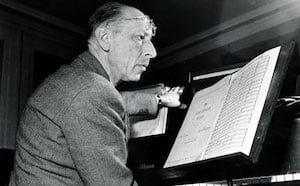
The ensemble saved the headlining Soldier’s Tale for the grand finale, performing it without narration or staging in its music-only, concert-suite version. Director Chad Goodman led the seven-piece outfit (violin, bass, clarinet, bassoon, trumpet, trombone, and percussion) in a performance of big-band proportions. The work consists of brash circus marches and sleazy cabaret numbers, filled with slinky melodies and dissonant, seemingly out-of-tune harmonies. Elevate didn’t shy away from some fittingly rough playing and blasting out big, boisterous climaxes.
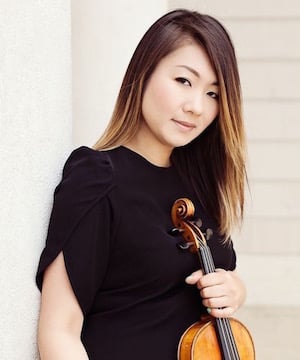
They might have backed off in some passages — violinist Yuri Kye was too-often overpowered by the muscular brass and woodwinds. It was a shame, because the piece is something of a miniature violin concerto, with virtuosic double- and triple-stops for the solo violinist. But Kye did have a chance to shine in the “Three Dances” movement: The opening tango was especially tasty, with Kye showing off her instrument’s husky lower register. Her heavy bowing and generous use of portamento made for a particularly folksy rendition. There were also some excellent solo moments from her colleagues. In the over-the-top “Royal March,” comically fat-sounding grunts from trombonist Alex Bedner and bassoonist Kris King contrasted nicely with trumpeter Ari Michich’s agile, cascading quintuplets.
Listening to Stravinsky’s score, I was struck by the number of prescient moments that seemed to pave the way for minimalism — passages constructed of unending ostinatos, like some organ grinder cranking out the same mechanical tune. It’s no surprise, then, that the present-day composers featured on the program drew on minimalism in their homage pieces, written for the same instrumental forces as The Soldier’s Tale.
In his 2011 Recovering, Christopher Cerrone isolated the first measure of the Stravinsky’s “Pastorale” movement, which became the central kernel of a solo-vibraphone part in Cerrone’s piece. Percussionist Divesh Karamchandani repeated the little motive dozens of times in both its original form and slight variations. He’s a detail-oriented player with a subtle handling of dynamics, as evidenced earlier in the evening during the short solo-marimba work Astral Dance (1979) by Gordon Stout. But unlike Stout’s elegant amuse bouche, Cerrone’s piece didn’t provide much engaging material for Karamchandani to work with. It’s a bland, unchallenging composition typical of the so-called “post-minimalist” school that dominates on the East Coast.
While Recovering made for a pretty, sparkling “meditation,” as conductor Goodman called it, it lacked the edge of Stravinsky’s piece — or of more hardline minimalist works by Reich or Glass, for that matter. In addition, Cerrone didn’t seem sure of what to do with the other six players in the ensemble; the violin and bass merely provided some plush accompanimental pedal points, occasionally growing into a screechy crescendo, and the winds were relegated to blowing out pitchless air tones, which simply sounded like the auditorium’s heater turning on.

Elevate’s composer-in-residence Julie Barwick fared slightly better in her Thirty-three Years. For this world-premiere work, Barwick devised a scenario in which the titular soldier, three decades after his unfortunate encounter with the Devil, looks back on the string of misfortunes he suffered.
The piece began with a kind of deconstructed version of the opening “Soldier’s March” movement from the Stravinsky. Barwick paraphrased the militaristic drum-and-bugle fanfares, pairing them with a lopsided version of the original oom-pah bassline. This “remix” soon gave way to something reminiscent of John Adams — a pop-tinged, head-bobbing riff peppered with syncopated rhythms. In the final slow section, clarinetist Jonathan Szin played a dreamy clarinet solo drawn from the serpentine, grace-note-studded clarinet melody of the same “Pastorale” movement that Cerrone borrowed from. In Barwick’s hands, however, Stravinsky’s solo was softened into something lyrical and less chromatic, like a theme from Copland’s Appalachian Spring — nostalgic and sentimental, conjuring visions of corn fields rather than cabaret halls.
Barwick noted in her preperformance comments that her own work dealt with the “feelings and memories” of Stravinsky’s soldier. Yet this seemed to show a misunderstanding of the source material. Though Barwick described the main character in almost Proustian terms, Charles-Ferdinand Ramuz’s libretto for The Soldier’s Tale is closer akin to Lewis Carroll or nursery-rhyme poetry. The roles are colorful cartoon characters, and Stravinsky’s sarcastic, unimpassioned score tells us that we shouldn’t take the soldier’s plight too seriously. The sentimentalized melodies that Barwick wrote, while lovely, are alien to the parodistic world of The Soldier’s Tale. She’s mistaken Ramuz and Stravinsky’s cardboard cutouts for flesh-and-blood human beings that feel and reminisce. Like Cerrone’s homage, Barwick’s work ultimately falls short of its model, proving that the magic behind Stravinsky’s jazzy little masterpiece is elusive and easy to misconstrue.

